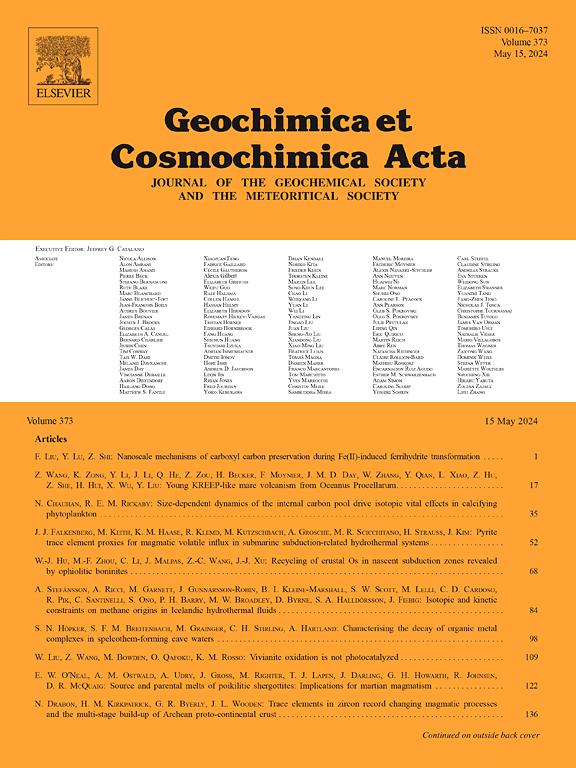碳化硅在低压H2-H2O气体混合物中的蒸发动力学:对原太阳盘中太阳前碳化硅颗粒生存能力的影响
IF 5
1区 地球科学
Q1 GEOCHEMISTRY & GEOPHYSICS
引用次数: 0
摘要
在原始地外物质中发现的太阳系前碳化硅(SiC)颗粒可以保存原太阳盘中尘埃吸积前的热历史。在H2-H2O混合物的总压力为0.5和2.5 Pa, H2/H2O比控制在 ~ 52-140,温度为1523-1779 K的条件下,进行了三个系列的SiC蒸发实验。加热后样品的tem - eds和拉曼光谱分析表明,样品表面没有氧化层;然而,偶尔会观察到多孔的富碳层。这表明,在实验条件下,SiC的蒸发过程没有形成保护性的稳态SiO2层。在所有实验条件下,蒸发通量(J)对温度的依赖性很小或没有,通常高于~ 1610-1670 K,而在较低温度下观察到较大的温度依赖性。J的温度依赖性很小/不依赖表明蒸发反应速率是由原太阳盘中低压条件下向SiC表面供气的H2O控制的。在大温度依赖状态下,总反应速率受到表面化学反应的限制。与以往的研究相比,本研究得到的大活化能可能与从没有连续SiO2形成的SiC蒸发到伴随SiO2形成的过渡状态有关。本文章由计算机程序翻译,如有差异,请以英文原文为准。
Evaporation kinetics of silicon carbide in a low-pressure H2-H2O gas mixture: Implications for the survivability of presolar silicon carbide grains in the protosolar disk
Presolar silicon carbide (SiC) grains found in primitive extraterrestrial materials would preserve the pre-accretion thermal history of dust in the protosolar disk. Three series of evaporation experiments of SiC were conducted at total pressures of 0.5 and 2.5 Pa of H2-H2O gas mixture with controlled H2/H2O ratios of ∼ 52–140 and temperatures of 1523–1779 K. The STEM-EDS and Raman spectroscopic analyses of the heated samples indicated the absence of an oxide layer on the sample surface; however porous carbon-rich layers were occasionally observed. This suggests that the evaporation of SiC under the experimental conditions proceeded without the formation of a protective steady-state SiO2 layer. Under all the experimental conditions, the evaporation flux (J) has little/no dependence on temperatures typically higher than ∼1610–1670 K, while larger temperature dependences were observed at lower temperatures. The little/no temperature-dependence of J suggests that the evaporation reaction rate is controlled by the gaseous supply of H2O to the SiC surface under low-pressure conditions prevailing in the protosolar disk. The overall reaction rates would be limited by the surface chemical reactions in the large-temperature dependent regime. The large activation energies in this regime obtained in this study compared with those reported from the previous studies are likely associated with the transition regime from the SiC evaporation without continuous SiO2 formation to that accompanied by the SiO2 formation.
The survivability of presolar SiC grains was then compared with that of presolar amorphous silicate grains. We found that the lifetime of 0.1–1 μm-diameter SiC grain in the protosolar disk would have little/no temperature dependence at temperatures higher than ∼1500–1700 K, whereas it has a large temperature dependence at lower temperatures. The survival of these presolar SiC grains during the formation of igneous calcium-aluminum-rich inclusions would largely depend on the heating conditions of high-temperature events. Effective SiC evaporation reaction would occur at ∼1200–1400 K, whereas oxygen isotopic signatures of 0.1 μm-diameter presolar amorphous silicate grains would be erased at ∼ 600–800 K in the accreting ptotosolar disk. At temperatures lower than ∼ 600–700 K, the presolar silicate/SiC number ratio normalized to its initial ratio increases with increasing the heliocentric distance from the Sun (r), reaching values of ∼ 0.7–0.9 at r > 4–5 au if the particles were released at ∼ 6–12 au. Assuming that the primitive interplanetary dust particles (IDPs) have an initial presolar silicate/SiC ratio of ∼ 6, the IDP-normalized ratios in primitive carbonaceous chondritic meteorites are in the range of ∼ 0.15–1. The high normalized presolar silicate/SiC ratios (>∼0.7) in meteorites imply that precursor materials of these meteorites originated predominantly from the regions with temperatures of < 300 K, corresponding to r of >∼4–5 au in this model. Our results indicate that the ratio of presolar silicate to SiC grains in the minimally altered primitive extraterrestrial materials may serve as a potential proxy for constraining the pre-accretional thermal history of the materials in the protosolar disk.
求助全文
通过发布文献求助,成功后即可免费获取论文全文。
去求助
来源期刊

Geochimica et Cosmochimica Acta
地学-地球化学与地球物理
CiteScore
9.60
自引率
14.00%
发文量
437
审稿时长
6 months
期刊介绍:
Geochimica et Cosmochimica Acta publishes research papers in a wide range of subjects in terrestrial geochemistry, meteoritics, and planetary geochemistry. The scope of the journal includes:
1). Physical chemistry of gases, aqueous solutions, glasses, and crystalline solids
2). Igneous and metamorphic petrology
3). Chemical processes in the atmosphere, hydrosphere, biosphere, and lithosphere of the Earth
4). Organic geochemistry
5). Isotope geochemistry
6). Meteoritics and meteorite impacts
7). Lunar science; and
8). Planetary geochemistry.
 求助内容:
求助内容: 应助结果提醒方式:
应助结果提醒方式:


